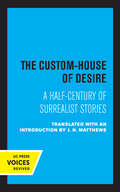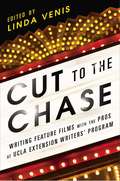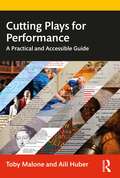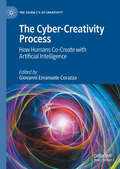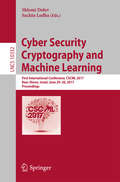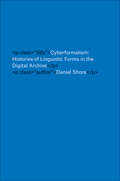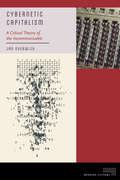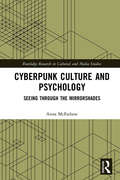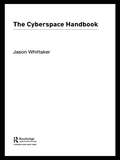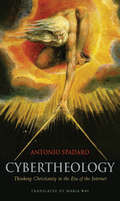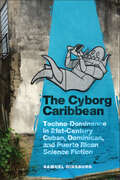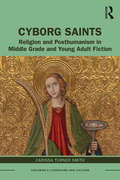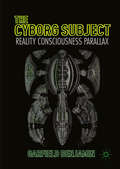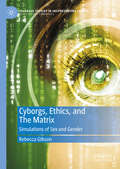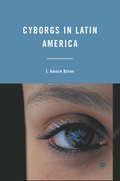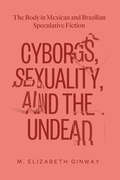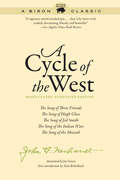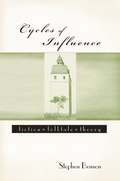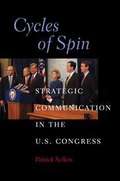- Table View
- List View
The Custom House of Desire: A Half-Century of Surrealist Stories
by J. H. MatthewsThis title is part of UC Press's Voices Revived program, which commemorates University of California Press’s mission to seek out and cultivate the brightest minds and give them voice, reach, and impact. Drawing on a backlist dating to 1893, Voices Revived makes high-quality, peer-reviewed scholarship accessible once again using print-on-demand technology. This title was originally published in 1975.
Cut/Copy/Paste: Fragments from the History of Bookwork
by Whitney TrettienHow do early modern media underlie today&’s digital creativity? In Cut/Copy/Paste, Whitney Trettien journeys to the fringes of the London print trade to uncover makerspaces and collaboratories where paper media were cut up and reassembled into radical, bespoke publications. Bringing these long-forgotten objects back to life through hand-curated digital resources, Trettien shows how early experimental book hacks speak to the contemporary conditions of digital scholarship and publishing. As a mixed-media artifact itself, Cut/Copy/Paste enacts for readers what Trettien argues: that digital forms have the potential to decenter patriarchal histories of print.From the religious household of Little Gidding—whose biblical concordances and manuscripts exemplify protofeminist media innovation—to the queer poetic assemblages of Edward Benlowes and the fragment albums of former shoemaker John Bagford, Cut/Copy/Paste demonstrates history&’s relevance to our understanding of current media. Tracing the lives and afterlives of amateur &“bookwork,&” Trettien creates a method for identifying and comprehending hybrid objects that resist familiar bibliographic and literary categories. In the process, she bears witness to the deep history of radical publishing with fragments and found materials.With many of Cut/Copy/Paste&’s digital resources left thrillingly open for additions and revisions, this book reimagines our ideas of publication while fostering a spirit of generosity and inclusivity. An open invitation to cut, copy, and paste different histories, it is an inspiration for students of publishing or the digital humanities, as well as anyone interested in the past, present, and future of creativity.
Cut Loose Your Stammering Tongue: Black Theology in the Slave Narratives
by Dwight N. Hopkins George C. L. CummingsDrawing on slave narratives found in forty-one volumes of interviews and one hundred autobiographies by former slaves, these contributors explore how enslaved African Americans received the often oppressive faith of their masters but transformed it into a gospel of liberation. This classic work demonstrates how an authentic black theology of liberation today must listen to the divine spirit that once fed and continues to feed the black religious experience. This second edition includes three additional provocative essays.
Cut to the Chase
by Linda VenisAccomplished writers from the renowned UCLA Extension Writers' Program provide an invaluable how-to book for aspiring feature film writers Millions of people dream of writing a screenplay but don't know how to begin, or are already working on a script but are stuck and need some targeted advice. Or maybe they have a great script, but no clue about how to navigate the choppy waters of show business. Enter Cut to the Chase, written by professional writers who teach in UCLA Extension Writers' Program, whose alumni's many credits include Pirates of the Caribbean: Curse of the Black Pearl; Twilight; and the Academy Award nominated Letters from Iwo Jima. From learning how to identify story ideas that make a good movie to opening career doors and keeping them open, this authoritative, comprehensive, and entertaining book, edited by Writers' Program Director Linda Venis, will be the film-writing bible for decades to come.
Cutting Plays for Performance: A Practical and Accessible Guide
by Toby Malone Aili HuberCutting Plays for Performance offers a practical guide for cutting a wide variety of classical and modern plays. This essential text offers insight into the various reasons for cutting, methods to serve different purposes (time, audience, story), and suggests ways of communicating cuts to a production team. Dealing with every aspect of the editing process, it covers structural issues, such as plot beats, rhetorical concepts, and legal considerations, why and when to cut, how to cut with a particular goal in mind such as time constraints, audience and storytelling, and ways of communicating cuts to a production team. A set of practical worksheets to assist with the planning and execution of cuts, as well as step-by-step examples of the process from beginning to end in particular plays help to round out the full range of skills and techniques that are required when approaching this key theatre-making task. This is the first systematic guide for those who need to cut play texts. Directors, dramaturgs, and teachers at every level from students to seasoned professionals will find this an indispensable tool throughout their careers.
The Cyber-Creativity Process: How Humans Co-Create with Artificial Intelligence (The Seven C’s of Creativity)
by Giovanni Emanuele CorazzaThis edited book explores the process of creating using the seven C's of creativity framework. It discusses the creative process as a collaboration between humans and Artificial Intelligence (AI), here identified as the cyber-creativity process. Through nine chapters written by leading scholars in the field, this collection delves into the rapidly emerging area of Generative-AI (Gen-AI) applications and sheds light on the parts of the creative process that will remain fundamentally human throughout the foreseeable future, as well as those that will benefit more from AI-augmentation. Drawing on the dynamic definition of creativity, the contents encompass the Dynamic Universal Creative Process (DUCP) and the DA VINCI model, the design principles of Gen-AI algorithms, the cyber-creativity process in education, journalism, design, fashion, music, and its implications on intellectual property protection. A timely reflection on the complex and evolving relation between creativity and technology, this volume will interest academics, researchers, and students alike across humanities, social and hard sciences.
Cyber Ireland
by Claire LynchCyber Ireland explores, for the first time, the presence and significance of cyberculture in Irish literature. Bringing together such varied themes as Celtic mythology in video games, Joycean hypertexts and virtual reality Irish tourism, the book introduces a new strand of Irish studies for the twenty-first century.
Cyber Security Cryptography and Machine Learning: First International Conference, CSCML 2017, Beer-Sheva, Israel, June 29-30, 2017, Proceedings (Lecture Notes in Computer Science #10332)
by Shlomi Dolev Sachin LodhaThis book constitutes the proceedings of the first International Symposium on Cyber Security Cryptography and Machine Learning, held in Beer-Sheva, Israel, in June 2017. The 17 full and 4 short papers presented include cyber security; secure software development methodologies, formal methods semantics and verification of secure systems; fault tolerance, reliability, availability of distributed secure systems; game-theoretic approaches to secure computing; automatic recovery of self-stabilizing and self-organizing systems; communication, authentication and identification security; cyber security for mobile and Internet of things; cyber security of corporations; security and privacy for cloud, edge and fog computing; cryptography; cryptographic implementation analysis and construction; secure multi-party computation; privacy-enhancing technologies and anonymity; post-quantum cryptography and security; machine learning and big data; anomaly detection and malware identification; business intelligence and security; digital forensics; digital rights management; trust management and reputation systems; information retrieval, risk analysis, DoS.
Cyberformalism: Histories of Linguistic Forms in the Digital Archive
by Daniel ShoreA groundbreaking study of how abstract linguistic signs circulate in literature, intellectual history, and popular culture.Linguistic forms are essential to meaning: like words, they make a semantic contribution to the things we say. We inherit them from past writers and speakers and fill them with different words to produce novel utterances. They shape us and the ways we interpret the world. Yet prevalent assumptions about language and the constraints of print-finding tools have kept linguistic forms and their histories hidden from view. Drawing on recent work in cognitive and construction grammar along with tools and methods developed by corpus and computational linguists, Daniel Shore’s Cyberformalism represents a new way forward for digital humanities scholars seeking to understand the textual past. Championing a qualitative approach to digital archives, Shore uses the abstract pattern-matching capacities of search engines to explore precisely those combinatory aspects of language—word order, syntax, categorization—discarded by the "bag of words" quantitative methods that are dominant in the digital humanities. While scholars across the humanities have long explored the histories of words and phrases, Shore argues that increasingly sophisticated search tools coupled with growing full-text digital archives make it newly possible to study the histories of linguistic forms. In so doing, Shore challenges a range of received metanarratives and complicates some of the most basic concepts of literary study. Touching on canonical works by Shakespeare, Milton, Wordsworth, and Kant, even as it takes the full diversity of digitized texts as its purview, Cyberformalism asks scholars of literature, history, and culture to revise nothing less than their understanding of the linguistic sign.
Cyberhate in the Context of Migrations (Postdisciplinary Studies in Discourse)
by Angeliki Monnier Axel Boursier Annabelle SeoaneThis edited book takes an interdisciplinary approach to shed light on the complex dynamics involved in the incidence of online hate speech against migrants in user-generated contexts. The authors draw on case studies from Finland, France, Germany, Italy, Poland and the UK, bringing together qualitative and quantitative analyses on user-generated online comments. The authors argue that online hate speech against migrants must be understood as a symptom of a representation crisis on migration, which can only be fully perceived through the study of the complex linguistic, interactional and connective processes within which it emerges. They focus on representations and shared meanings, community building and otherness, and delve into the role of network ecosystems in the process of the construction of public problems. This book will be of interest to undergraduate and post-graduate students as well as academics working on hate speech and migration studies in a variety of fields, and can also contribute to improving research protocols for automated analyses and detections of online hate speech.
Cybernetic Capitalism: A Critical Theory of the Incommunicable (Meaning Systems)
by Jan OverwijkA Conceptual Interrogation of Capital in a Cybernetic Environment Cybernetic Capitalism presents a groundbreaking synthesis of Niklas Luhmann's systems theory and critical theory. Overwijk examines how neoliberal capitalism now thrives on the management of incommunicability rather than the pursuit of total communicability, harnessing ecological complexity as its driving force. Contrary to earlier critiques that highlighted capitalism's push to render all social life fully communicable, the current era encourages market incalculability, profits from user unpredictability, and spurs serviceworkers' creativity.This ecological logic resonates with the extractivist drive of the Anthropocene, reframing our understanding of capitalism as an adaptive, environment-attuned system. Cybernetic Capitalism also exposes how these dynamics intersect with the cultural rise of conspiracy theories and radical-right irrationalism. By illuminating capitalism's paradoxical reliance on both rationalist and irrationalist currents, Overwijk provides a vital new lens for interpreting the complex politics of our time.
Cyberpunk Culture and Psychology: Seeing through the Mirrorshades (Routledge Research in Cultural and Media Studies)
by Anna McFarlaneThis book traces developments in cyberpunk culture through a close engagement with the novels of the ‘godfather of cyberpunk’, William Gibson. Connecting his relational model of ‘gestalt’ psychology and imagery with that of the posthuman networked identities found in cyberpunk, the author draws out relations with key cultural moments of the last 40 years: postmodernism, posthumanism, 9/11, and the Anthropocene. By identifying cyberpunk ways of seeing with cyberpunk ways of being, the author shows how a visual style is crucial to cyberpunk on a philosophical level, as well as on an aesthetic level. Tracing a trajectory over Gibson’s work that brings him from an emphasis on the visual that elevates the human over posthuman entities to a perspective based on touch, a truly posthuman understanding of humans as networked with their environments, she argues for connections between the visual and the posthuman that have not been explored elsewhere, and that have implications for future work in posthumanism and the arts. Proposing an innovative model of reading through gestalt psychology, this book will be of key importance to scholars and students in the medical humanities, posthumanism, literary and cultural studies, dystopian and utopian studies, and psychology.
Cybersemiotics
by Soren BrierA growing field of inquiry, biosemiotics is a theory of cognition and communication that unites the living and the cultural world. What is missing from this theory, however, is the unification of the information and computational realms of the non-living natural and technical world. Cybersemiotics provides such a framework.By integrating cybernetic information theory into the unique semiotic framework of C.S. Peirce, Søren Brier attempts to find a unified conceptual framework that encompasses the complex area of information, cognition, and communication science. This integration is performed through Niklas Luhmann's autopoietic systems theory of social communication. The link between cybernetics and semiotics is, further, an ethological and evolutionary theory of embodiment combined with Lakoff and Johnson's 'philosophy in the flesh.' This demands the development of a transdisciplinary philosophy of knowledge as much common sense as it is cultured in the humanities and the sciences. Such an epistemological and ontological framework is also developed in this volume.Cybersemiotics not only builds a bridge between science and culture, it provides a framework that encompasses them both. The cybersemiotic framework offers a platform for a new level of global dialogue between knowledge systems, including a view of science that does not compete with religion but offers the possibility for mutual and fruitful exchange.
The Cyberspace Handbook
by Jason WhittakerThe Cyberspace Handbook is a comprehensive guide to all aspects of new media, information technologies and the internet. It gives an overview of the economic, political, social and cultural contexts of cyberspace, and provides practical advice on using new technologies for research, communication and publication. The Cyberspace Handbook includes: *a glossary of over eighty key terms*a list of over ninety web resources for news and entertainment, new media and web development, education and reference, and internet and web information* specialist chapters on web design and journalism and writing on the web*Over thirty illustrations of internet material and software applications.Jason Whittaker explores how cyberspace has been constructed, how it is used and extends into areas as different as providing us immediate news or immersive games and virtual technologies for areas such as copyright and cybercrime, as well as key skills in employing the internet for research or writing and designing for the Web.
Cybertheology: Thinking Christianity in the Era of the Internet
by Antonio Spadaro S.J.Because the Internet has changed and is changing the ways in which we think and act, it must also be changing the ways in which we think Christianity and its theology. Cybertheology is the first book to explore this process from a Catholic point of view. Drawing on the theoretical work of authors such as Marshall McLuhan, Peter Levy, and Teilhard de Chardin, it questions how technologies redefine not only the ways in which we do things but also our being and therefore the way we perceive reality, the world, others, and God. “Does the digital revolution affect faith in any sense?” Spadaro asks. His answer is an emphatic Yes. But how, then, are we to live well in the age of the Internet?Spadaro delves deeply into various dimensions of the impact of the Net on the Church and its organization, on our understanding of revelation, grace, liturgy, the sacraments, and other classical theological themes. He rightly points out that the digital environment is not merely an external instrument that facilitates human communication or a purely virtual world, but part of the daily experience of many people, a new “anthropological space” that is reshaping the way we think, know, and express ourselves. Naturally, this calls for a new understanding of faith so that it makes sense to people who live and work in the digital media environment. In developing the notion of cybertheology, Spadaro seeks to propose an intelligence of faith (intellectus fidei) in the era of the Internet.The book’s chapters include reflections on man the decoder and the search engines of God, networked existence and the mystical body, hacker ethics and Christian vision, sacraments and “virtual presence,” and the theological challenges of collective intelligence.
The Cyborg Caribbean: Techno-Dominance in Twenty-First-Century Cuban, Dominican, and Puerto Rican Science Fiction (Critical Caribbean Studies)
by Samuel GinsburgThe Cyborg Caribbean examines a wide range of twenty-first-century Cuban, Dominican, and Puerto Rican science fiction texts, arguing that authors from Pedro Cabiya, Alexandra Pagan-Velez, and Vagabond Beaumont to Yasmin Silvia Portales, Erick Mota, and Yoss, Haris Durrani, and Rita Indiana Hernandez, among others, negotiate rhetorical legacies of historical techno-colonialism and techno-authoritarianism. The authors span the Hispanic Caribbean and their respective diasporas, reflecting how science fiction as a genre has the ability to manipulate political borders. As both a literary and historical study, the book traces four different technologies—electroconvulsive therapy, nuclear weapons, space exploration, and digital avatars—that have transformed understandings of corporality and humanity in the Caribbean. By recognizing the ways that increased technology may amplify the marginalization of bodies based on race, gender, sexuality, and other factors, the science fiction texts studied in this book challenge oppressive narratives that link technological and sociopolitical progress. .
Cyborg Saints: Religion and Posthumanism in Middle Grade and Young Adult Fiction (Children's Literature and Culture)
by Carissa Turner SmithSaints are currently undergoing a resurrection in middle grade and young adult fiction, as recent prominent novels by Socorro Acioli, Julie Berry, Adam Gidwitz, Rachel Hartman, Merrie Haskell, Gene Luen Yang, and others demonstrate. Cyborg Saints: Religion and Posthumanism in Middle Grade and Young Adult Fiction makes the radical claim that these holy medieval figures are actually the new cyborgs in that they dethrone the autonomous subject of humanist modernity. While young people navigate political and personal forces, as well as technologies, that threaten to fragment and thingify them, saints show that agency is still possible outside of the humanist construct of subjectivity. The saints of these neomedievalist novels, through living a life vulnerable to the other, attain a distributed agency that accomplishes miracles through bodies and places and things (relics, icons, pilgrimage sites, and ultimately the hagiographic text and its reader) spread across time. Cyborg Saints analyzes MG and YA fiction through the triple lens of posthumanism, neomedievalism, and postsecularism. Cyborg Saints charts new ground in joining religion and posthumanism to represent the creativity and diversity of young people’s fiction.
The Cyborg Subject
by Garfield BenjaminThis book outlines a new conception of the cyborg in terms of consciousness as the parallax gap between physical and digital worlds. The contemporary subject constructs its own internal reality in the interplay of the Virtual and the Real. Reinterpreting the work of Slavoj Žižek and Gilles Deleuze in terms of the psychological and ontological construction of the digital, alongside the philosophy of quantum physics, this book offers a challenge to materialist perspectives in the fluid cyberspace that is ever permeating our lives. The inclusion of the subject in its own epistemological framework establishes a model for an engaged spectatorship of reality. Through the analysis of online media, digital art, avatars, computer games and science fiction, a new model of cyborg culture reveals the opportunities for critical and creative interventions in the contemporary subjective experience, promoting an awareness of the parallax position we all occupy between physical and digital worlds.
Cyborgs, Ethics, and The Matrix: Simulations of Sex and Gender (Palgrave Studies in (Re)Presenting Gender)
by Rebecca GibsonThe Matrix (Lana Wachowski and Lilly Wachowski 1999) has permeated our cultural consciousness for two decades, working its way into such common parlance as “a glitch in the Matrix,” and the idea of taking the Red Pill. With the release of the fourth movie, The Matrix Resurrections (Lana Wachowski 2021), and the confirmation of the franchise being a metaphor for gender transition, this book examines how the entire franchise contributes to the discourse on sex and gender, and how it has been instrumental in propelling the creation of new types of cyborg technology. This book centers on the main philosophical theme of The Matrix, know thyself, and relate it to the quest for authenticity which creates our identities—be they human, or human “enough”—as we move through the world.
Cyborgs in Latin America
by J. Andrew BrownA PDF version of this book is available for free in open access via the OAPEN Library platform, www. oapen. org . Cyborgs in Latin America explores the ways cultural expression in Latin America has grappled with the changing relationships between technology and human identity.
Cyborgs, Sexuality, and the Undead: The Body in Mexican and Brazilian Speculative Fiction
by M. Elizabeth GinwayWriters in Brazil and Mexico discovered early on that speculative fiction provides an ideal platform for addressing the complex issues of modernity, yet the study of speculative fictions rarely strays from the United States and England. Cyborgs, Sexuality, and the Undead expands the traditional purview of speculative fiction in all its incarnations (science fiction, fantasy, horror) beyond the traditional Anglo-American context to focus on work produced in Mexico and Brazil across a historical overview from 1870 to the present. The book portrays the effects—and ravages—of modernity in these two nations, addressing its technological, cultural, and social consequences and their implications for the human body. In Cyborgs, Sexuality, and the Undead, M. Elizabeth Ginway examines all these issues from a number of theoretical perspectives, most importantly through the lens of Bolívar Echeverría&’s &“baroque ethos,&” which emphasizes the strategies that subaltern populations may adopt in order to survive and prosper in the face of massive historical and structural disadvantages. Foucault&’s concept of biopolitics is developed in discussion with Roberto Esposito&’s concept of immunity and Giorgio Agamben&’s distinction between &“political life&” and &“bare life.&” This book will be of interest to scholars of speculative fiction, as well as Mexicanists and Brazilianists in history, literary studies, and critical theory.
A Cycle of the West, Bison Classic Annotated Edition: The Song of Three Friends, The Song of Hugh Glass, The Song of Jed Smith, The Song of the Indian Wars, The Song of the Messiah
by John G. Neihardt Alan BirkelbachA Cycle of the West rewards its readers with a sweeping saga of the American West and John G. Neihardt’s exhilarating vision of frontier history. It is infused with wonder, nostalgia, and a keen appreciation of epic history. Unquestionably the masterpiece of the poet who has been called the “American Homer,” A Cycle of the West celebrates the land and legends of the Old West in five narrative poems: The Song of Three Friends (1919), The Song of Hugh Glass (1915), The Song of Jed Smith (1941), The Song of the Indian Wars (1925), and The Song of the Messiah (1935). This unforgettable epic of discovery, conquest, courage, and tragedy speaks movingly and resoundingly of a unique American experience. The new introduction by former Texas poet laureate Alan Birkelbach and annotations by Joe Green present fresh views of Neihardt’s iconic work.
Cycles of Influence: Fiction, Folktale, Theory
by Stephen BensonIn this wide-ranging and insightful analysis, Stephen Benson proposes a poetics of narrative for postmodernism by placing new emphasis on the folktale. Postmodernist fictions have evidenced a return to narrative--to storytelling centered on a sequence of events, rather than a "spiraling" of events as found in modernism--and recent theorists have described narrative as a "central instance of the human mind." By characterizing the folktale as a prime embodiment of narrative, Benson relates folktales to many of the theoretical concerns of postmodernism and provides new insights into the works of major writers who have used this genre, which includes the subgenre of the fairy tale, in opening narrative up to new possibilities. Benson begins by examining the key features of folktales: their emphasis on a chain of events rather than description or consciousness, their emphasis on a self-contained fictional environment rather than realism, the presence of a storyteller as a self-confessed fabricator, their oral and communal status, and their ever-changing state, which defies authoritative versions. He traces the interactions between the folktale and Italo Calvino's Fiabe Italiane, between selected fictions of John Barth and the Arabian Nights, between the work of Robert Coover and the subgenre of the fairy tale, and between the "Bluebeard" stories and recent feminist retellings by Angela Carter and Margaret Atwood. The arguments presented will interest not only folklorists and scholars of narrative but also readers in fields ranging from comparative literature to feminist theory.
Cycles of Spin: Strategic Communication in the U. S Congress
by Patrick SellersHow do politicians try to shape their news coverage? Sellers examines strategic communication campaigns in the U.S. Congress. He argues that these campaigns create cycles of spin: leaders create messages, rank-and-file legislators decide whether to promote those messages, journalists decide whether to cover the messages, and any coverage feeds back to influence the policy process. These four stages are closely related; decisions at one stage influence those at another. Sellers uses diverse evidence, from participant observation and press secretary interviews, to computerized content analysis and vector auto regression. The result is a comprehensive and unprecedented examination of politicians' promotional campaigns and journalists' coverage of those campaigns. Countering numerous critics of spin, Sellers offers the provocative argument that the promotional messages have their origins in the actual policy preferences of members of Congress. The campaigns to promote these messages thus can help the public learn about policy debates in Congress.
The Cylinder
by Helmut Müller-SieversThe Cylinder investigates the surprising proliferation of cylindrical objects in the nineteenth century, such as steam engines, phonographs, panoramas, rotary printing presses, silos, safety locks, and many more. Examining this phenomenon through the lens of kinematics, the science of forcing motion, Helmut Müller-Sievers provides a new view of the history of mechanics and of the culture of the industrial revolution, including its literature, that focuses on the metaphysics and aesthetics of motion. Müller-Sievers explores how nineteenth-century prose falls in with the specific rhythm of cylindrical machinery, re-imagines the curvature of cylindrical spaces, and conjoins narrative progress and reflection in a single stylistic motion. Illuminating the intersection of engineering, culture, and literature, he argues for a concept of culture that includes an epoch's relation to the motion of its machines.
